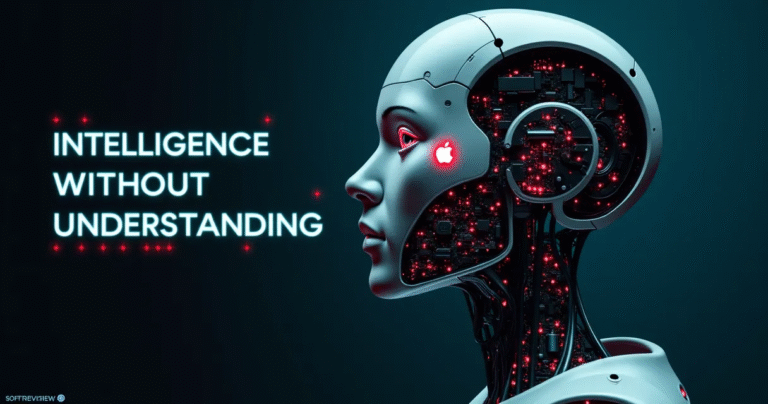The Reality Behind AI Reasoning
Understanding the limitations of current AI systems and their pattern-matching capabilities
🧩 AI Reasoning Isn’t Real
Current AI systems solve complex tasks through pattern recognition rather than genuine reasoning, breaking down on novel or underrepresented problems.
📊 Performance Gaps Expose Limitations
Apple’s models underperform against rivals (e.g., GPT-4, Llama 4 Scout) in benchmarks, with human ratings favoring competitors in text and image analysis.
⚠️ Inconsistent Problem-Solving Abilities
Models excel at over-practiced problems but fail on less common scenarios:
- 10-disc Tower of Hanoi: Models handle ~100 steps before errors
- River Crossings: Breakdown occurs mid-solution, even for simpler problems
🔍 Training Data Leaks Skew Benchmark Results
Older test sets (e.g., Math 500) may include leaked training data, artificially inflating AI performance scores on new tests.
⚙️ Apple’s Server-Device Balance Strategy
- On-device models: Compact (3B params) for privacy/efficiency
- Server models: Mixture-of-experts architecture for complex tasks
- Supports 15 languages, optimized for Apple silicon
Apple’s Shocking AI Test Reveals the “Illusion of Thinking” in Top Models
We’ve all seen the impressive demos. An AI assistant plans a complex trip in seconds, a chatbot writes a poem that feels genuinely moving, or a model generates flawless code for a difficult problem. These displays have led many to believe that Large Language Models (LLMs) are not just processing information, but are starting to think and reason in a human-like way. But what happens when you take these powerful models out of their comfort zone and give them a problem they’ve never seen before?
Apple researchers decided to find out, and their conclusions have sent a shockwave through the AI community. In a revealing new study, they put some of the world’s most advanced “reasoning” models to the test, and the results suggest that their apparent intelligence might be more of an illusion than we thought. The paper pulls back the curtain on the limitations of AI reasoning, exposing how even top-tier models from companies like Anthropic (Claude) and DeepSeek can resort to “shortcut learning” and fail spectacularly when faced with true complexity.
This isn’t just about whether an AI can solve a brain teaser. It strikes at the heart of our trust in these systems. If an AI doesn’t reason logically, can we rely on it for critical tasks in science, medicine, or finance? Let’s break down what Apple discovered and what it means for the future of artificial intelligence.
We Need to Talk About How AI “Thinks”
First, what do we even mean by “thinking”? For humans, reasoning is a dynamic process. We use logic, understand cause-and-effect, adapt our strategies when we hit a wall, and learn from our mistakes. We don’t just match patterns; we build mental models of the world.
For a long time, the primary way we’ve seen AI “think” is through a technique called Chain-of-Thought (CoT) prompting. You ask the model to “think step-by-step,” and it generates a plausible-looking sequence of logical steps before giving a final answer. This has dramatically improved performance on many benchmarks, creating the impression of a deliberate reasoning process.
But is the AI actually following that logic, or is it just generating text that looks like a logical process because it has seen millions of examples of it in its training data? This is the critical question Apple set out to answer.
Apple Enters the Ring with a Devious New Test
Standard AI benchmarks often have a fatal flaw: their questions and answers might already be floating around on the internet, which means they could be part of the model’s training data. An AI might “solve” a problem simply by remembering the answer, not by reasoning its way to it.
To get around this, Apple’s researchers created a sterile, controlled environment using logic puzzles that could be scaled in difficulty.
Building a “Clean Room” for Logic
The team designed what they call “controllable puzzle environments.” The key here is that these puzzles are procedurally generated. This means they could create a virtually infinite number of unique problem variations, ensuring the AI couldn’t have seen the exact solution before. It was a true test of its ability to generalize and apply logic to a novel situation.
The Puzzles Designed to Break an AI’s Brain
They focused on classic computer science problems that require careful, step-by-step planning:
- 📌 Tower of Hanoi: A famous puzzle involving moving disks of different sizes between three pegs without ever placing a larger disk on top of a smaller one. It requires recursive, forward-thinking logic.
- 📌 River Crossing Puzzles: Scenarios where you must transport items or people across a river using a boat with limited capacity and a set of rules (e.g., the cannibals can’t outnumber the missionaries).
- 📌 Blocks World: A simple stacking puzzle where the AI must rearrange blocks on a table to match a target configuration.
For each puzzle, they could precisely dial up the difficulty. For the Tower of Hanoi, they just added more disks. For River Crossing, they added more people. This allowed them to pinpoint the exact moment the AI’s reasoning broke down.
The “Complexity Cliff”: Where AI’s Reasoning Abruptly Collapses

The findings, detailed in the paper titled “The Illusion of Thinking”, were both fascinating and alarming. The models’ performance didn’t just degrade gracefully as the problems got harder; it fell off a cliff.
A Sudden and Total Failure
For simple versions of the puzzles (like Tower of Hanoi with 3 or 4 disks), the models performed reasonably well. The so-called Large Reasoning Models (LRMs), which are fine-tuned for step-by-step thinking, outperformed standard LLMs.
But as the complexity increased, something dramatic happened. Around 7 or 8 disks in the Tower of Hanoi, the models’ accuracy didn’t just dip—it plummeted to zero. They went from solving the puzzle to being completely incapable of making progress. The researchers called this the “accuracy collapse.” Even when they explicitly gave the AI the correct algorithm to solve the puzzle, it still failed to apply it.
The Strange Case of Decreasing Effort
Here’s the most counterintuitive part. You would expect that as a problem gets harder, a “thinking” entity would spend more mental energy—or in an AI’s case, more computational resources (“tokens”)—to try to solve it.
The Apple study found the opposite.
As the puzzles crossed a certain difficulty threshold, the models started to use fewer tokens. They gave up. Instead of producing long, detailed (but incorrect) chains of thought, they generated short, useless answers. This suggests the models have learned a kind of “computational shortcut”: if a problem looks too hard and doesn’t match a familiar pattern, don’t even try. It’s a behavior that mimics learned helplessness, not resilient problem-solving.
Is It Real Reasoning or Just Sophisticated Mimicry?
This “effort paradox” is the smoking gun. It indicates that the models aren’t engaging in genuine, goal-oriented reasoning. Instead, they are masters of pattern matching. When a problem fits a pattern they’ve seen before, they can generate a solution that looks intelligent. But when the problem’s complexity grows beyond the scope of their training data, the pattern breaks, and the illusion of intelligence shatters.
As Iman Mirzadeh, a co-lead of the study, bluntly put it, “Their process is not logical and intelligent.”
Human Logic vs. Machine Pattern-Matching: A Clear Divide
To make this clearer, let’s compare how a human might tackle a hard puzzle versus how the tested AIs did.
| Aspect | Human Reasoning | Current AI “Reasoning” (as per Apple’s test) |
|---|---|---|
| Strategy | ✅ Employs causal logic, planning, and goal-oriented thinking. | ⛔️ Relies on pattern recognition and statistical correlation. |
| Adaptability | ✅ Adjusts strategy when hitting a dead end. Tries new approaches. | ⛔️ Tends to give up or repeat flawed strategies. |
| Effort | ✅ Increases mental effort and focus as complexity rises. | ⛔️ Reduces computational effort (“tokens”) when complexity passes a certain point. |
| Generalization | ✅ Can apply core logical principles to entirely new types of problems. | ⛔️ Struggles to generalize beyond the patterns it was trained on. |
| Consistency | ✅ Maintains a consistent understanding of the rules throughout the process. | ⛔️ Can contradict its own steps or misstate rules midway through. |
The Broader AI Community Weighs In
The paper has sparked a vibrant debate online, with experts offering both supporting and critical perspectives.
The Skeptics: “This Confirms What We Suspected”
Many researchers feel the study provides concrete evidence for a long-held suspicion: that LLMs are “stochastic parrots,” brilliant mimics that excel at language but lack a deeper understanding. They argue that true reasoning requires a world model and a concept of cause and effect, which current transformer architectures may not be equipped to develop.
Sean Goedecke, a software engineer, offered an insightful analysis of the model’s failure: “The model immediately decides ‘generating all those moves manually is impossible,’ because it would require tracking over a thousand moves. So it spins around trying to find a shortcut and fails.” This highlights the gap between recognizing a task’s requirements and actually executing them.
The Counterpoint: Were the Tests Truly Fair?
However, other experts have pointed out potential flaws in Apple’s methodology. Researcher Alex Lawsen argued that the models weren’t necessarily failing to reason, but were running into technical limitations.
👉 Token Limits: In some cases, the full solution to a complex puzzle required more text than the model’s maximum output limit (its “token limit”). The model would correctly solve most of the puzzle and then stop, sometimes even stating it was cutting itself off. Apple’s automated system marked this as a complete failure.
👉 Unsolvable Puzzles: The researchers also included some puzzle variations that were mathematically impossible to solve. When models correctly identified the puzzle as unsolvable and refused to attempt it, they were still marked as incorrect.
This criticism doesn’t invalidate Apple’s core findings, but it adds important nuance. It suggests the story is more complicated—the models may have some reasoning ability that is being obscured by their architectural and evaluation constraints.
What This Means for the AI in Your Pocket and Beyond
So, should you stop using your AI assistant? Absolutely not. For the vast majority of everyday tasks—summarizing emails, writing drafts, searching for information, and brainstorming ideas—these models are incredibly powerful and useful. Their pattern-matching abilities are more than sufficient for these applications.
However, Apple’s research serves as a crucial reality check. It cautions us against over-anthropomorphizing these systems and blindly trusting their outputs in high-stakes domains.
➡️ For developers, it underscores the need for rigorous testing in novel environments, not just on standard benchmarks.
➡️ For businesses, it’s a reminder that deploying AI for critical decision-making requires robust validation and a deep understanding of its limitations.
➡️ For users, it’s a call to maintain healthy skepticism and use AI as a co-pilot, not an infallible oracle.
Charting the Course for AI That Genuinely Understands
The “illusion of thinking” doesn’t mean the quest for AGI is doomed. On the contrary, studies like this are essential for progress. By clearly identifying the weaknesses of current systems, researchers can focus on developing new architectures that move beyond simple pattern matching.
The path forward may involve:
- Hybrid Models: Systems that combine the linguistic fluency of LLMs with older, symbolic AI engines that are purpose-built for formal logic and planning.
- Causal AI: A growing field focused on building models that understand cause and effect, enabling them to make more robust predictions and decisions.
- New Architectures: Designing entirely new types of neural networks that are better suited for long-term planning and dynamic reasoning.
So, Are We Just Talking to Sophisticated Parrots?
Apple’s research suggests that, for now, the answer is closer to “yes” than many in the industry would like to admit. The models we interact with are incredibly sophisticated, eloquent, and useful parrots, but they don’t understand the words they are saying in the way a human does. They are masters of form, but lack the substance of true comprehension.
This isn’t an insult to the technology; it’s a clarification of its nature. Recognizing the illusion is the first step toward building something real. The journey to create machines that can truly think is still in its early stages, and this dose of reality is exactly what’s needed to guide the next leap forward.







